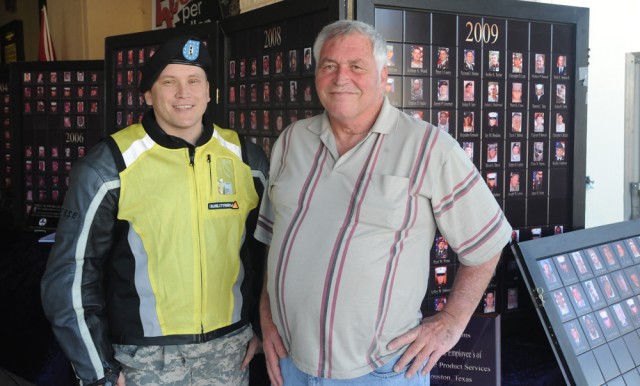FORT HOOD, Texas -Walls usually divide us.
But they stood side-by-side, two Soldiers separated by a generation of service in wars in different parts of the world - Vietnam and Iraq.
Chief Warrant Officer 2 Mike Ebinal, 2nd Brigade Combat Team, 1st Cavalry Division, who served in Iraq, and Carson George, a Houston contractor who served in Vietnam during the Tet offensive of 1968, are joined by walls commemorating the lives and deaths of men who fought for and served their country.
Ebinal's wall, erected in Kirkuk, Iraq, contains the hand-painted names of 4,350 service members who have died in Afghanistan and Iraq, including Sgt. Leroy Webster, a 2nd BCT Soldier killed while on a dismounted patrol in Kirkuk City.
"He took a shift for a sick Soldier and lost his life," Ebinal said.
The memorial wall is located next to a distinguished visitor's pad dedicated to Webster.
Although constructed of painted concrete, Ebinal believes the wall is a work of art.
"Every piece of concrete there had some sort of meaning about somebody for someone else," he said.
George's wall, the Afghanistan/Iraq War Memorial Portrait Mural, was created as a project of the Military Order of the Purple Heart. It contains the names of hundreds of Texans who have died in the Middle East conflicts since 2001, including his son, William George, a 22-year-old Marine who was killed in Afghanistan in 2005 while returning from a search mission for Marcus Luttrell and his 12-man Navy SEAL team. Luttrell was the only survivor of that mission.
Ebinal and George accompanied the Texas wall, which was set up Feb. 28 at the Clear Creek Post Exchange.
"He and the Red Wings group ahead of him were hit by the same group (of Taliban insurgents) that shot down our Chinook and killed 26 men. He put his arm up to give a hand signal and get his men to safety and he took a round in his armpit," Carson said.
Of his idea to build a memorial wall in Kirkuk City, Ebinal said, "Most people laughed at me, even an NCOIC in my unit. It made me even more determined."
In 2009, Ebinal contacted Air Force Master Sgt. Don Albee. "He ran his Air Force guys, I ran the Army guys and together we and the KBR crew made it happen," Ebinal said.
That's when he met Carson George.
"He was taking pictures of a distinguished visitor's pad we were setting up. He coordinated his guys to paint our walls green," Ebinal said.
The memorial in Kirkuk City is about 280 feet long and is constructed from 13-foot by 12-foot Alaskan T-walls originally used for blast reduction and bunkers.
The names of the fallen heroes were hand-painted using yellow-gold paint.
"I had a pretty high number of people (in my unit) on that wall and (the idea came) while I was in Kuwait coming back from R&R. In the USO, they had banners across the ceiling listing everyone's name. It really hit you. That was what I wanted," Ebinal said.
Similarities aside, George believes the Texas memorial wall is unique "because, unlike the Vietnam (War Memorial) Wall or the wall in Iraq this gives a face to the name," George said.
The Texas wall consists of a series of panels made of four-inch-square ceramic tiles. Using a sublimation process, the photographs of the fallen are put on transfer paper and pressed onto the tiles.
Despite his personal connection to the Texas wall, George said: "It goes beyond my son ... All of our fallen, from 1775 on, no longer just belong to their families, they belong to the nation. It's that nation's responsibility and duty to remember the price. Because if we forget what it took to get us to where we are, that's when we lose our freedom."
Although he travels with it, the Texas memorial wall was not his idea, George emphasized.
"The first wall like this one was done for state of Florida; Texas was the second state. I think there are five or six of them now," he added.
After its viewing at Fort Hood, the Texas memorial wall was escorted in a convoy that includes the DPS and 1st Cavalry Division Horse Detachment to Houston, where it was displayed during the Houston Livestock and Rodeo.
The trailer that carried the display was pulled by a truck owned by Jerry Turner, whose road name is "Water Boy."
"I carry the water and flags and this memorial," Turner, a Patriot Guard member who served in Vietnam as a helicopter pilot with the 101st Airborne Division, said.
Both Ebinal and George believe the walls can unite and heal people wounded by war.
The wall in Kirkuk City contains the word "Welcome" written in Pashtun, the language of the dominant native tribe in Iraq.
George, who was a Kellogg, Brown and Root contractor stationed in Iraq in 2005, said an Iraqi friend who he told about his son's death "could only hug me with tears in his eyes."
"He had lost a relative two weeks earlier who was killed when a suicide bomber blew himself up in a restaurant in Baghdad," George said.
He often gets comments about the wall on his Facebook page from surviving family members.
"Gold Star parents say they just want their loved ones to be remembered. That is their greatest fear; that they will be forgotten. It won't happen," George said.


Social Sharing